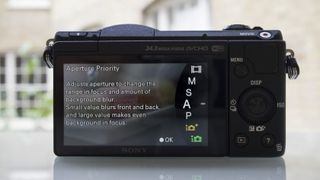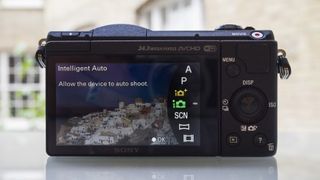Why you can trust TechRadar
With the same sensor and processing engine as the A6000, we were pretty confident that the A5100 would also deliver excellent results - in fact it's fair to say that probably the biggest difference between these cameras is handling, not performance.
Colours directly from the camera are bright and vibrant, displaying a good level of saturation. You can adjust how colours are outputted directly from the camera by altering Creative Style. Here you'll find options such as Vivid, Portrait, Black and White and Landscape.

Each of these are customisable - you can increase the contrast for instance - and have the benefit of being able to shoot these styles in raw format, leaving you with a clean version of the image should you need it.
Detail is rendered extremely well by the 24.3 million pixel sensor, with lots of fine detail found right across the scene. This is especially true when looking at an image at normal printing or web sizes - and even when zooming in at 100%, the impression of detail is still great, giving you good scope to crop an image if you need to improve composition.
In the majority of cases, the a5100's metering system copes well to produce accurate exposures, however you may find in some very high contrast situations it is beneficial to dial in some exposure compensation.

Also very useful is the Dynamic Range Optimiser function; this helps you to get a balanced exposure when one area of the scene is darker or brighter than the rest of it. There are five levels you can choose from, or leave the camera to automatically detect the appropriate level. Shooting at DRO Level 5 is perhaps best avoided as it can leave the scene looking a little fake, but 1-4 are very handy indeed.
Similarly, the camera's automatic white balance does a decent job of producing accurate colours in most situations. That said, it can err a little towards warmer tones under artificial light, and if there are two different types of light in a scene, it's unlikely you'll be able to get a wholly accurate overall picture. Switching to a more appropriate white balance setting can be beneficial if you're finding the warm tones to be displeasing.

One of the benefits of the new Bionz X processor, Sony claims, is its better ability in low light shooting scenarios. Pleasingly, the A5100 copes very well with high sensitivity settings - at ISO 3200 for instance, you get an excellent overall impression of detail and low noise. If you examine at 100%, you can see some areas of the image have a slight painterly effect, but overall detail is kept fairly well.
If you examine the raw format equivalent of a JPEG image, you can see how heavy-handed the camera's in-noise reduction is. You can set your own level of noise reduction using Sony's raw data converter software, or in third-party software such as Photoshop when Adobe Camera Raw is updated. This is useful if you would prefer to keep detail rather than smooth out noise.

Other than Creative Styles, you can experiment with different Picture Effects if you want to get creative. These can only be shot in JPEG format, but are still worth experimenting with to see if any particularly appeal. I'm a fan of Toy Camera and High Contrast Monochrome, but it will be down to personal taste.
It would be nice to see Sony giving you the option to shoot in raw format here, as you might change your mind about the filter down the line - it's something I keep hoping to see with every new Alpha.
The supplied kit lens is a decent all-round performer, producing sharp images and giving you plenty of flexibility in terms of its focal range. There's a decent number of lenses available now for the Sony E mount if you decide you want to expand your repertoire. A particular favourite of mine is the 50mm f/1.8 lens, which is great for shooting shallow depth of field images, or when shooting in low light conditions.

Another benefit of the Bionz X processor is the increased speed of both autofocusing and general operational speeds. Although not quite as quick as the A6000, or indeed Micro Four Thirds cameras, the A5100 locks onto targets under good light quickly and easily.
As the light drops, so do autofocus acquisition speeds, but it's rare for a false positive confirmation of focus to be presented. Shot-to-shot times are decent, and moving through the menus and screens is also pretty swift.
Current page: Performance
Prev Page Build Quality and Handling Next Page Image quality and resolutionAmy has been writing about cameras, photography and associated tech since 2009. Amy was once part of the photography testing team for Future Publishing working across TechRadar, Digital Camera, PhotoPlus, N Photo and Photography Week. For her photography, she has won awards and has been exhibited. She often partakes in unusual projects - including one intense year where she used a different camera every single day. Amy is currently the Features Editor at Amateur Photographer magazine, and in her increasingly little spare time works across a number of high-profile publications including Wired, Stuff, Digital Camera World, Expert Reviews, and just a little off-tangent, PetsRadar.


